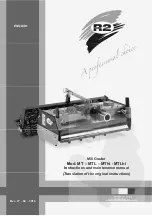
High flow speeds (up to 20 m/s) result in chemical corrosion of the titanium
components when used in high-oxidizing acids.
The dispersion tool can be disassembled for cleaning as described below:
• Unscrew the rotor
(15)
from the rotary shaft
(9)
using the generator
and shaft wrenches included in the tool kit. The generator wrench is
used to hold the rotor while unscrewing it by turning the shaft from
above with the shaft wrench.
• Unscrew the stator
(14)
from the shaft
(10) (left-hand thread)
.
Insert the cross pin (3mm) of the shaft wrench into the slot on the
end face of the shaft tube. The stator can now be unscrewed by tur-
ning it in the clockwise direction with the generator wrench.
• Pull the rotary shaft
(9)
down and out of the shaft tube. The com-
ponents
(7
;
11
und
12)
threaded on to the shaft can simply be pul-
led off.
• The bearing bushing
(7)
muust be replaced if it is worn.
Reassamble the dispersion tool in the reverse sequence. When assam-
bling ensure that the bearing bushing is correctly installed. The stator
must only be screwed on to the shaft tube by hand.
Spare parts : Item
Designation
2
Grooved pin
7
PTFE bearing bushing
8
Adapter
10
Shaft tube
12
Bushing
13
Shaft sleeve
14
Stator
15
Rotor
2001
Rotary shaft assembly
19
082006
Spare parts:
Item
Designation
2
Grooved pin
4
Deep-groove ball bushing
5
Circlip
8
Friction ring seal assembly
12
Shaft tube
2001
Rotary shaft assembly
3007
Spring
3008
Flat seal
3009
Round seal
3010
Pin
3011
Round seal
Sterilization :
After cleaning the dispersion tools the method
A)
is suitable for this disper-
sion tool. The methods
B)
and
C)
must not be used otherwise the ball bea-
ring and the friction ring seal will be destroyed.
(See Maintenance, cleaning and sterilization of dispersion tools).
Overview (Fig. 3)
This dispersion tool meets all requirements for corrosion-resistance. The
parts coming into contact with the product are made from glass-reinforced
PTFE and titanium.
The PTFE components (shaft tube, stator and bearing bushing) are
relatively soft and thus permit operations in the liquid/liquid and
liquid/gaseous ranges.
Because PTFE softens at high temperatures a maximum medium
temperature of 100°C must not be exceeded.
Hard, abradant and abrasive materials must not be processed.
Dispersion tool S 50 TT - W 40 TT
















































